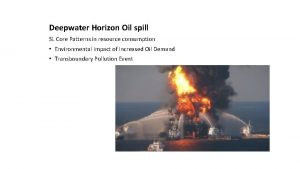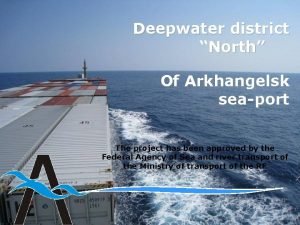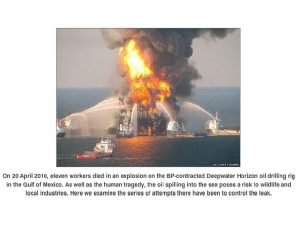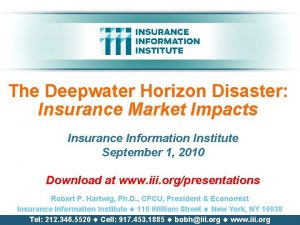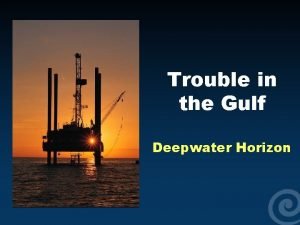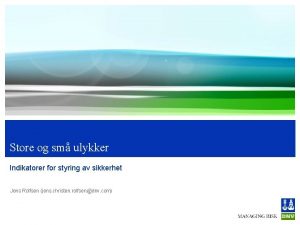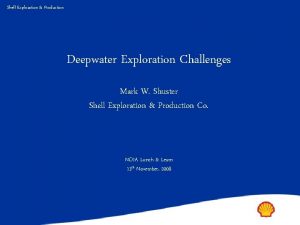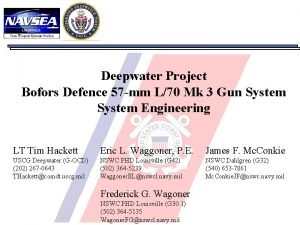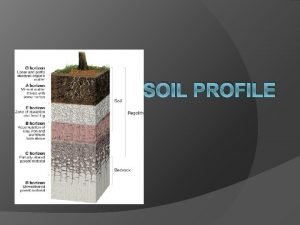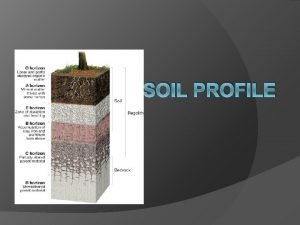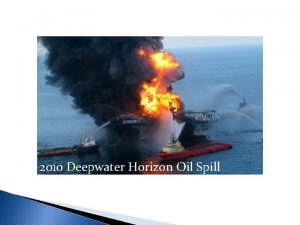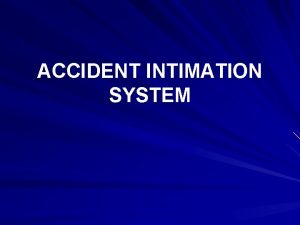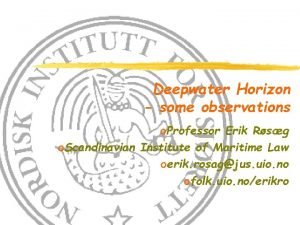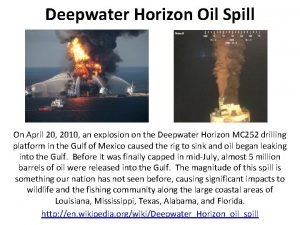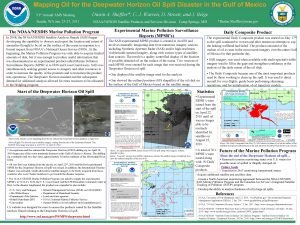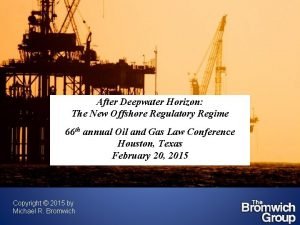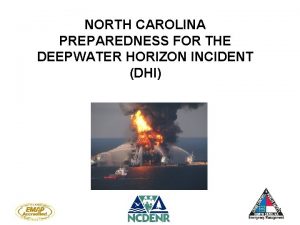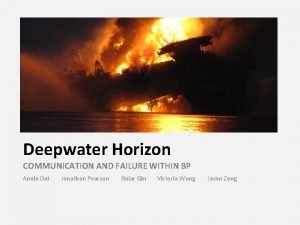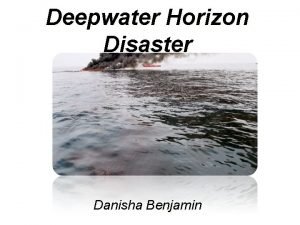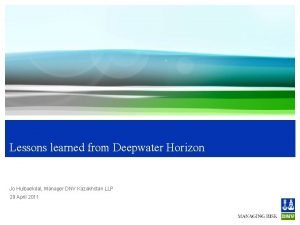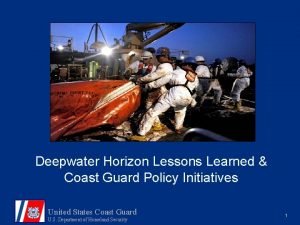P 8 Deepwater Horizon accident A summary of



















- Slides: 19

P. 8 -Deepwater Horizon accident A summary of the accident report and its consequences Source: USA review for improvement of MODU code rules 19 dec 2014 and SSE (sub committee on ships systems and Equipmant 1/20 Nov/ 2013

historical: April 2010 Ø Deepwater Horizon dynamic positionning drilling operations on MACONDO well Ø Blow out around 21. 00 then explosion and fire occured killing 11 lives and injuring 16 orhers and Ø Causing and Oil spill for 87 days Ø the largest oil spill in the USA history and environmental damage in the gulf of Mexico

Explosion ØDischarge of mud and oil and explosives gases from the derrick to the drill floor ØExplosion and big fire occured ØThen gases exploded again in other locations provoking total loss of power ØThe Master was on the bridge/control room ØThe OIM arrived 5 minutes later on the bridge

Confusion At the time of explosion there was confusion as to who was in charge and had the authority to order the emergency disconnect from the well ?

Then ØThe Master ordered to abandon the unit Ø Fire gang ready but no pressure from the fire mains system: unsucessful start of supply electrical for fire pumps ØFinally they could not disconnect and were not able to move away from the well flow

Causal analysis ØLoss of well control: drilling crew deviating from established well control practices ØCause of deaths: fatal injuries during the first explosion at the drill floor and poor blast protection ØPoor maintained electrical apparatus source of ignition ØCritical elements like gas detectors were by-passed

ØInadequate position of air inlet of generators (main & emergency) allowing impact of flammable gas on all of them ØBarriers between drill floor and crew quarters were only fire barriers instead of blast barriers ØThe classic command organization of OIM in charge except in emergency has provoked delays in decision making

Conformity of the unit ØWas constructed in conformance with 89 MODU code ØEven with amendements 2009, the investigation found that only protection are mainly from fire coming from kitchen or engine rooms but not from drilling oil blast or fire ØCritical elements and also escapes routes were not enough taken into account

Possibilities of improvement ØReinforcement of bulkheads (with H class) to protect (from blast & fire) occupied areas close to the drill floor and spaces housing vital machinery (critical equipment of the ISM code) bulkheads ØProtection of escape routes and survival craft areas from radiant heat ØBetter protection of the drill floor with fixed fire water-spraying extinguishing equipment

Ø Electrical apparatus in hazardous areas must be maintained and tested as critical elements Ø Increase the individual space for the offshore personnel in the life boats Ø Quaterly david-launched Liferafts drills should be organized even with a dedicated training raft Ø Man overboard drills with recovery should be organized quaterly Ø Reminder: abandon and fire drills are mandatory every week

Dual command ØSystematically designated as a permanent problem on board offshore units and not clearly specified in the MODU code ØThe person in charge (PIC) should have been the master during navigation or dynamic positionning operations (the unit is considered as a ship even vhen connected to the riser)

On board « Deepwater Horizon » ØThe unit was not fitted with an automatic stop in case of detection of flammable gas in the hazardous areas (machinery for dynamic positionning) ØThe stop was in hands of personnel who was required to give « special consideration » of that ØThe expression is again inapropriate given a too vague requirement (way of varying interpretations)

Automatic emergency shutdown or disconnexion of riser ØThe modu code was not clear for automatic close down and disconnection system ØAmendements are now proposed to equiped the MODU with this automatic device ØThis required notably for using back up systems for dynamic positionning to allow response to gas detectionalarms while maintening position keeping

Human factor ØThe human facyor was not clearly analysed in the offical reports. However an interesting section, which can explain why the individuals on board and on shore, accepted the poor safety culture and why safety was not considered in all tasks and actions:

ØIn March 2010, SMS Culture/Climate Audit and Review which included auditors conducting surveys at the Operator's offices and vessels over a two-week period was organized. The results indicated that "a significant proportion (43. 6%) of the personnel participating in the perception survey reported that they worked with a fear of reprisal if a casualty or near miss occurred. This issue is strongly related to the company's casualty investigation process, which nearly 40% of the participants believed was applied to apportion blame. »

ØAt a company where employees fear reprisal for whatever reason and when there are significant costs associated with any unscheduled shutdown or delay of drilling activities, it is unlikely that the crew would report safety issues even if it identified risks.

ØThere is also a note on complacency as it is stated in the report that the overall complacency of the MODU was a possible contributing cause of the kick detection failure and the crew's approach to fire drills.

Presentation to be linked with presentation 3 about discussion about futur amendements of the MODU code Feedback of the disaster is taken into account at the moment during the SSE 3 sub-committee

Thank You
 Deepwater horizon incident
Deepwater horizon incident Deepwater horizon incident
Deepwater horizon incident Deepwater horizon incident
Deepwater horizon incident Explosion gulf of mexico
Explosion gulf of mexico Brownsville lhwca lawyers
Brownsville lhwca lawyers Deepwater
Deepwater Workday deepwater
Workday deepwater Deepwater
Deepwater L/70 57mm
L/70 57mm Lost horizon summary
Lost horizon summary Bootstrapping yield curve
Bootstrapping yield curve Horizon nj health policy number
Horizon nj health policy number Www.horizon nj health.com
Www.horizon nj health.com A horizon
A horizon Soil food web horizon
Soil food web horizon E horizon
E horizon Soil horizon parent material
Soil horizon parent material Elluviation
Elluviation B horizon
B horizon Soil horizons o a e b c r
Soil horizons o a e b c r

